Imagine a workplace where collaboration is seamless, the duties and processes are well defined, and communication is the exact opposite of frustrating.
Sounds like a prime environment for creativity and innovation, doesn’t it?
Applicable to both individuals and teams, improving team dynamics can get a workplace to that ideal point. Good team dynamics allow your team to shine and avoid or overcome setbacks easily, and they also boost employee retention and improve productivity.
In this article, we will:
- Explain team dynamics and their importance,
- Define the primary factors that influence team dynamics,
- Provide 10 examples of good team dynamics, and
- Cover examples of bad team dynamics that you should avoid.
Let’s get right to it!
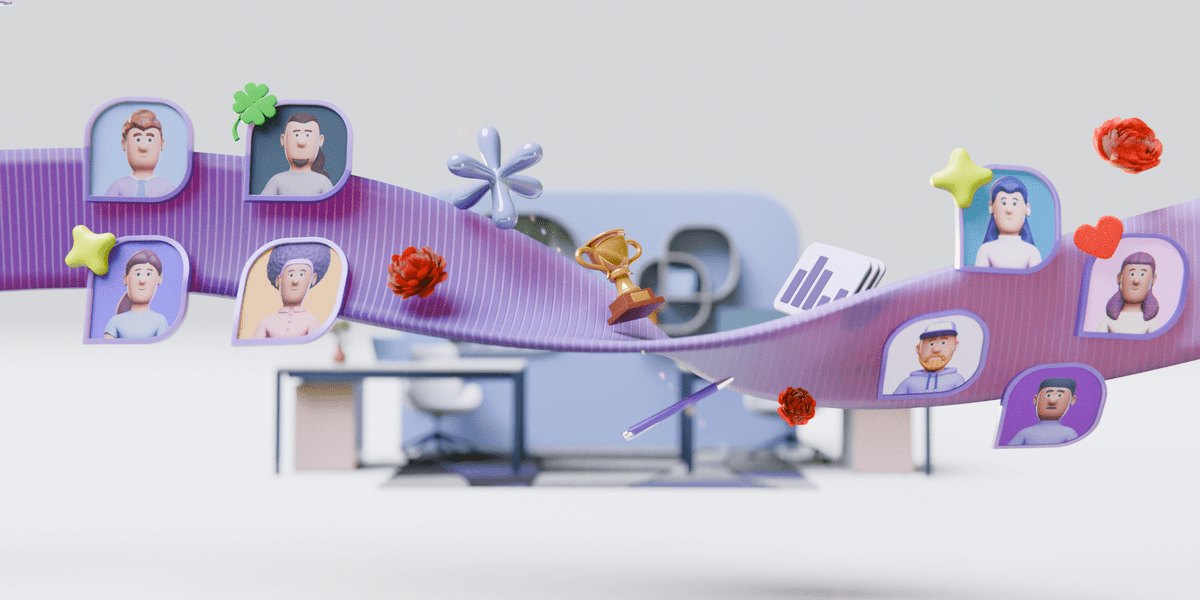
What is team dynamics?
Team dynamics refers to relationships between team members that reflect how they collaborate, communicate, and work together towards a common goal.
Many factors can influence team dynamics. The most notable ones include individual differences in personalities, cultures, and work styles, as well as the organization’s structure and hierarchy.
Some of the key elements of positive team dynamics include:
- Open communication,
- Optimism,
- Commitment, and
- Individual adaptability.
They lead to team cohesion and, most importantly, trust.
Why are team dynamics important?
The state of team dynamics is an indicator of the state of a team.
Good team dynamics ensure constant growth and development of a business, alongside its employees.
When team dynamics are well established, the group as a whole is synchronized and, as a result, more productive. That almost universally leads to:
- Happier customers,
- High team morale,
- More beneficial outcomes, and, in the long run,
- More revenue.
Let’s take a look at the primary factors that influence team dynamics.
🎓 Pumble Pro Tip
To learn more about how to develop a team successfully, check out our article on the 5 stages of group development based on Bruce Tuckman’s model:
3 key factors that influence team dynamics
Team dynamics are exclusively tied to people and their interactions. There are 3 principal factors that influence team dynamics:
- Personality differences,
- Leadership, and
- Organizational culture.
Each of these factors can be analyzed and improved in various ways.
Factor #1: Personality differences
This is the most uncontrollable factor in the workplace. Personal differences can range from cultural to temperamental and psychological ones.
Every personality type in a team unconsciously impacts team dynamics, either positively or negatively. The cumulative effect of different personalities in a workplace creates a psychological climate, which substantially influences productivity and behavior.
Individual tendencies and differences will shape how you build your desired organizational culture and how you lead people.
You may need to emphasize certain things for some team members even though they might feel “obvious” to you and synchronize different communication styles between team members to make for more effective communication.
Depending on your situation, you might even need to recruit new team members and/or say goodbye to some existing ones, to transform your team for the better.
Communicate effectively over Pumble
Factor #2: Leadership
After choosing your team, the next step is to establish a trustworthy leader.
A good leader is in charge of establishing:
- Accountability — ensuring responsibility awareness,
- Alignment — of precise roles and duties, and
- Transparency — openness and honesty in the workplace.
This makes for a productive team.
The team leader always dictates the tone of the environment. A good leader or manager has high social skills and can recognize problems and find solutions quickly with the help of others.
The opposite is also true. Bad leadership consists of many factors, but all of them are related to neglecting subordinates and poor decision-making skills.
The leader’s role is to guide and support their team while providing a good, psychologically safe environment. A leader must:
- Understand the people around them,
- Know their motivations, and
- Be able to inspire them.
Truly good leadership always leads to the progress of the organization, as well as individual team members.
Factor #3: Organizational culture
Organizational or company culture includes values and behaviors that shape the way you run your business, and treat and inspire your employees.
It comes as a natural extension of good leadership and well-balanced personality differences that we mentioned before. Organizational culture represents how employees, customers, stakeholders, and others experience the company.
Prioritize creating a positive work environment. In a positive environment, teams can live up to their true potential, as members flourish and motivate each other. A positive environment also nurtures a sense of belonging, which leaves all members willing to share new, exciting ideas that benefit them, their coworkers, and the business as a whole.
Sounds amazing, right?
Well, as you’re probably aware, it takes a lot of hard work to get there. Let’s see how successful teams do it.
🎓 Pumble Pro Tip
How can you be sure your workplace is a positive environment for everybody? Test yourself by checking out:
10 examples of effective team dynamics
So, what do good team dynamics look like?
Let’s take a look at the top 10 behaviors and elements of successful teams and explore how you can implement them in your organization. These elements and behaviors are prime examples of what brings about effective team dynamics.
Example #1: Transparent communication
Transparency in communication is one of the first things that comes to mind when talking about good team dynamics — and with good reason. Good business communication is the quintessential part of any successful organization.
Being transparent means communicating in a way that leaves everybody clear on their short-term and long-term work-related expectations.
Transparent communication also includes inspiring others to:
- Actively listen,
- Clearly express ideas, and
- Provide constructive feedback.
This is best done by setting an example.
A good team leader should bring a positive atmosphere and foster a proactive approach. This is best achieved by inspiring open and transparent communication first.
In the example below, we can see how Nina transparently shares expectations and fosters open communication with her team.
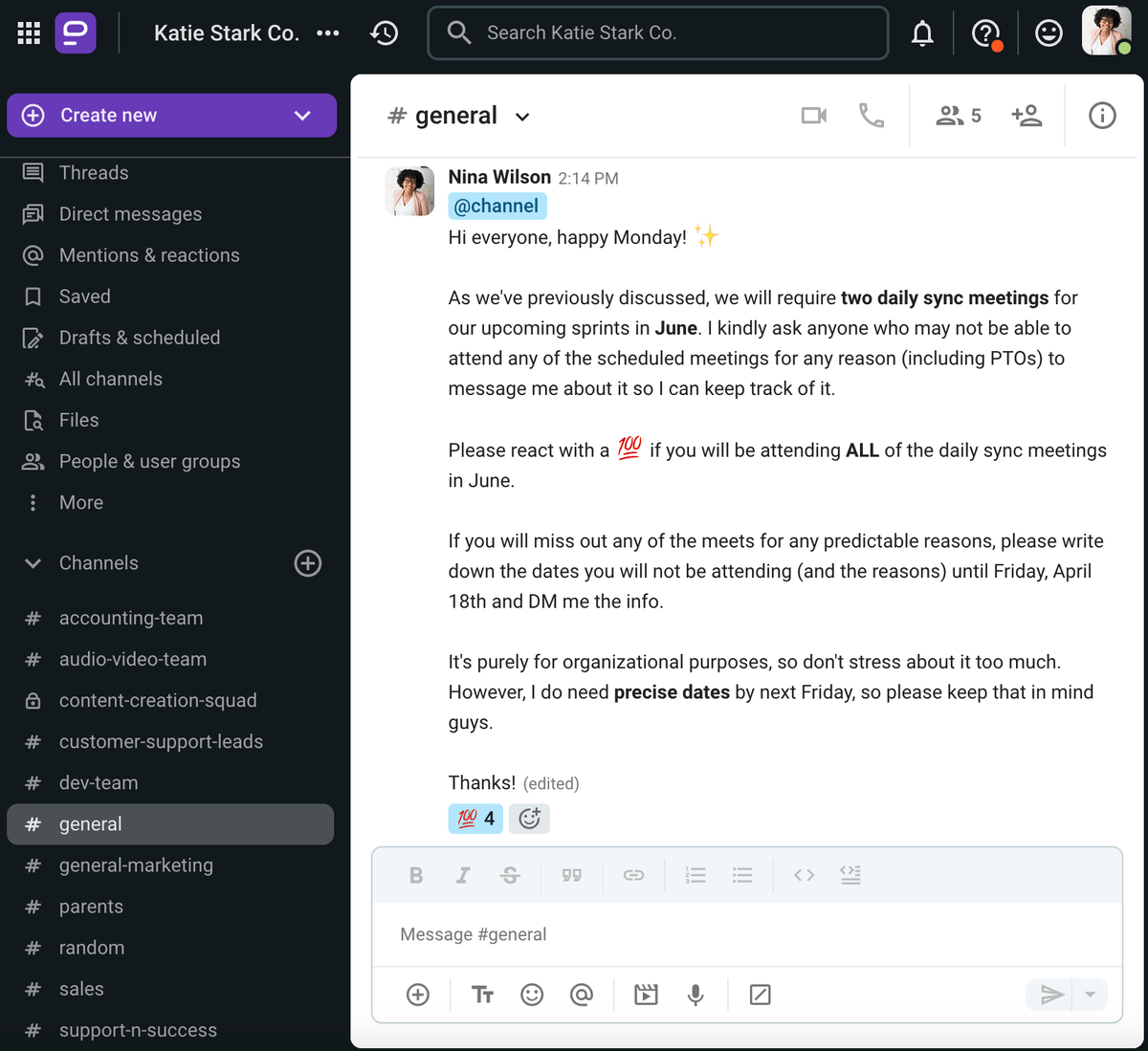
Keep your communication transparent with Pumble
Example #2: Defined roles and responsibilities
Having clearly defined team roles and responsibilities comes as an extension of transparent communication. It’s vital that every member of the team has all of the necessary information so they can perform their duties effectively.
When roles are precisely defined, the team is optimized, performance is greatly improved, work-related arguments are reduced, and the team reaps the benefits of good collaboration.
Defined responsibilities also include team members being aware of the responsibilities of other employees, at least in part. This way, they can understand the importance and the impact of their work in a team setting.
Defined roles and responsibilities allow for aligned team goals and broader organizational goals, and inspire individual goals within an organization.
Example #3: Constructive feedback
If any problems arise, all members of a team should receive constructive feedback so they can improve their efforts. Keep in mind that individual constructive feedback will be different for everybody — some people may appreciate one approach, while others could find it completely wrong for them.
A general rule of thumb for constructive feedback is that it always contains encouragement and acknowledgment of efforts as well as critiques and insightful improvement suggestions.
The feedback should always be targeted as personally as possible — aimed either at smaller groups or individuals. Effective feedback is structured in a way that’s concrete, concise, and fairly straightforward to apply.
To inspire giving constructive feedback to others as a leader, always try to:
- Be proactive,
- Suggest changes,
- Ask questions, and
- Inspire constructive exchanges whenever possible.
Avoid “no” statements and negative opinions without solid arguments. Always try to elaborate on any negative opinions you may have, to inspire improvement based on your tastes and takes on the situation at hand.
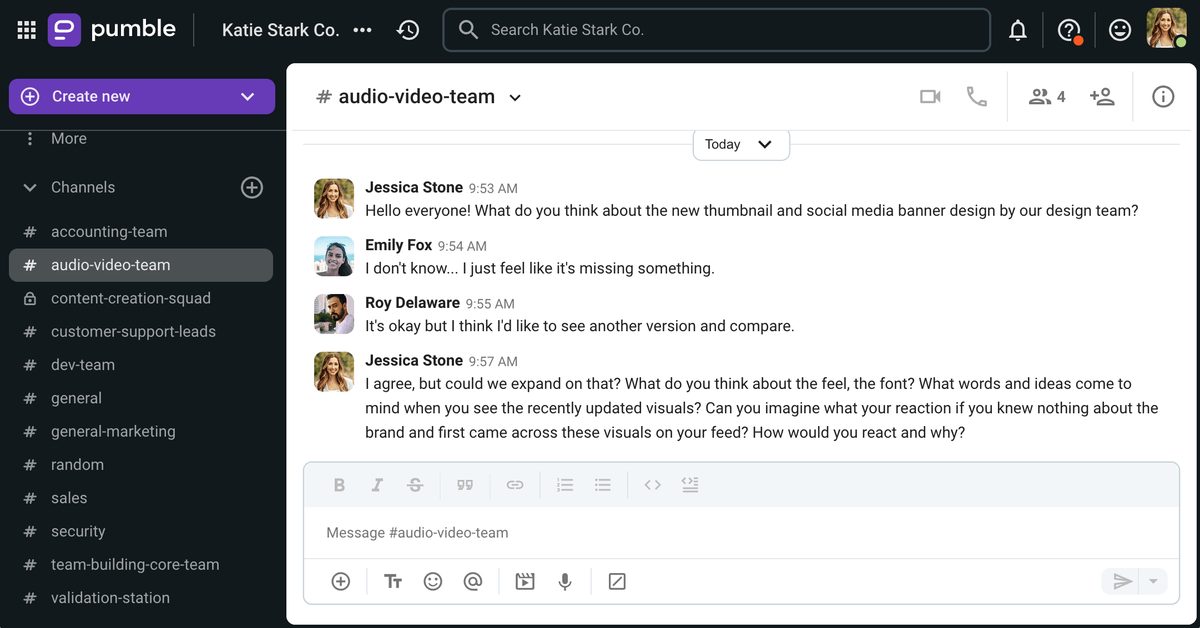
Hold feedback sessions over Pumble
🎓 Pumble Pro Tip
Ever considered feedforward instead of feedback? To master this new useful concept, check out:
Example #4: A supportive environment
A supportive environment is what comes as a result of all the previously mentioned team dynamics in any successful organization.
One of the best ways to achieve this is to set an example as a leader. Encourage team members to support one another and motivate each other as frequently as possible.
A supportive environment makes employees feel responsible and appreciated — but also “at home”.
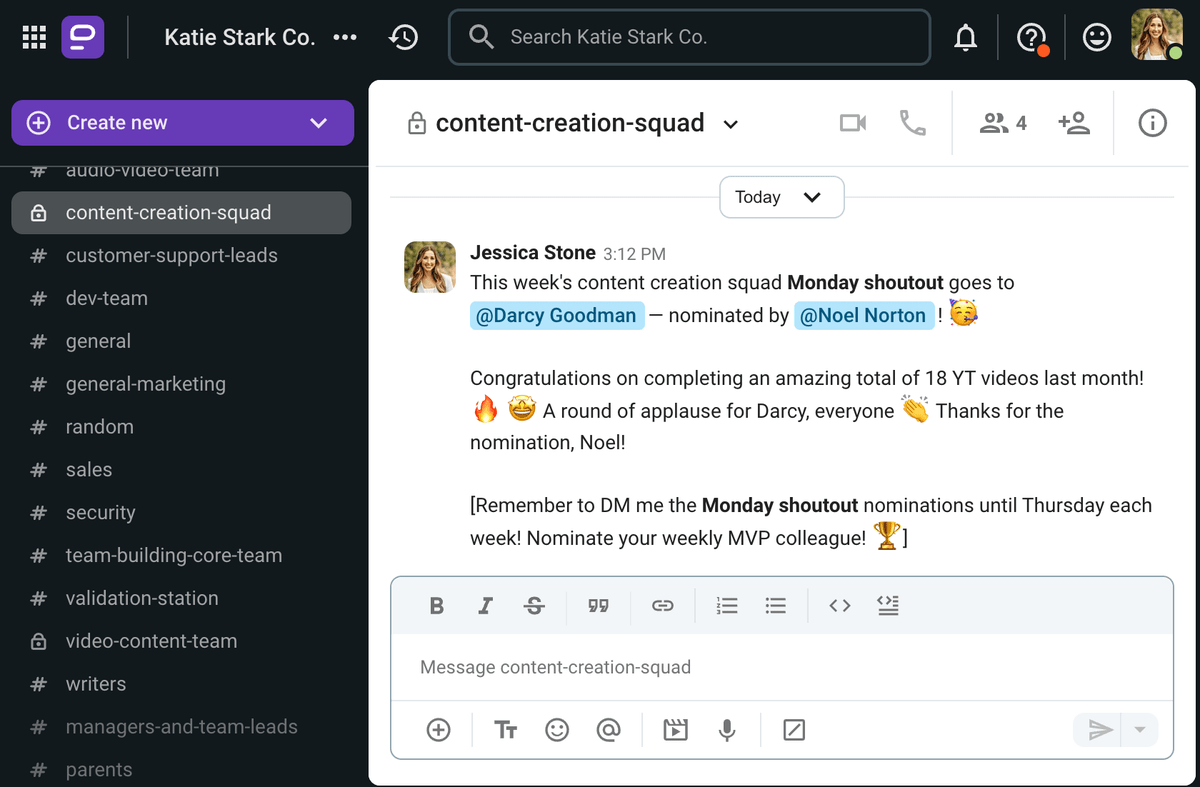
Example #5: Effective conflict resolution
In the event of any miscommunication or similar problems between teammates, you should strive to resolve conflicts quickly and in a way that makes everyone feel heard.
Either individually or through a group meeting including all conflict participants, conflicts should be addressed in a way that prevents them from ever repeating.
Conflicts can be an indicator that one or more of the aforementioned elements of positive team dynamics examples aren’t quite right.
For example, if your team members aren’t used to transparent communication, misunderstandings can easily arise. This can also happen if roles and responsibilities aren’t clearly defined.
Depending on the type of conflict, you may even be required to reorganize your team so that the incompatible personalities interact as little as possible. However, keep in mind that most good teams have cooperative, empathetic, and easily adaptable members to begin with.
🎓 Pumble Pro Tip
Want to get better at solving conflicts in the workplace? Check out:
Example #6: Purpose and meaning
If you’ve implemented everything we’ve talked about so far, purpose and meaning should arise naturally.
When every team member is aware of their duties and their impact and encouraged to improve and be constructive when criticizing their colleagues — in other words, if you’ve created a psychologically safe environment — people will easily develop a sense of belonging and purpose.
Shared goals also play a crucial role in developing these feelings. Consider improving the way your employees communicate within the team and directly rely on each other. Encourage direct communication where you think it is necessary and follow improvements.
If you notice any setbacks, change things again. Try to walk a mile in each of your employees’ shoes and eliminate any activities that in any way seem “pointless” from their perspective.
If this isn’t possible, address that you’re aware that certain processes may seem redundant but are formally necessary, so that your employees feel understood.
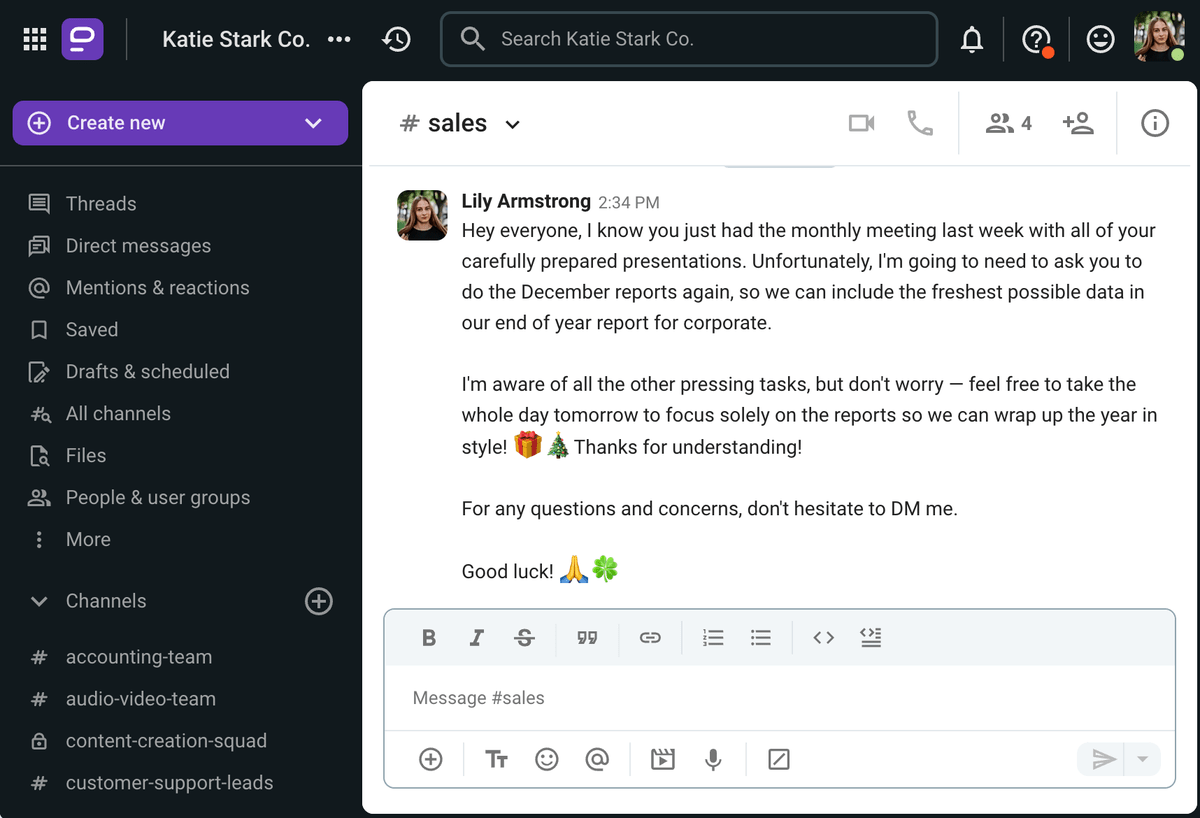
Example #7: Feeling of safety
In the context of team dynamics, the feeling of safety should primarily stem from being aware that it is okay to take risks, suggest ideas freely, and admit mistakes without fear of any consequences.
Even when difficult things need to be negotiated, every opinion should be heard and valued, and if required, steered to the most constructive side possible.
This sense of freedom comes not only from a supportive environment but also from the initiatives of the manager. It is the manager’s duty to remind employees of these facts every so often. Only then can the feeling of safety dominate the workplace.
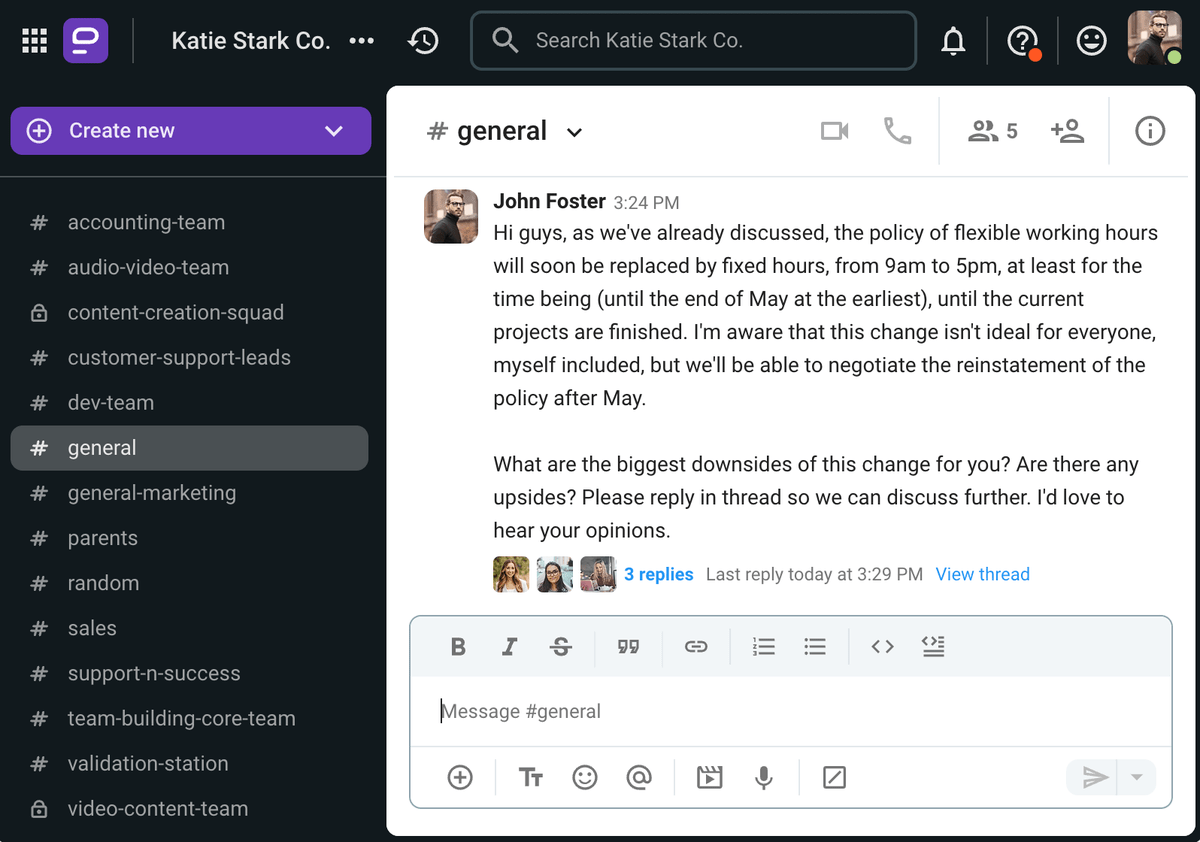
Example #8: Embracing diversity
People with different backgrounds can bring a lot to the table when given the opportunity.
Uniting people through their differences is something that will almost exclusively benefit any organization in the long run.
This refers to all kinds of diversity. Celebrating individual differences and including people from different backgrounds often leads to improved creativity and problem solving in the workplace, as well as improved financial performance.
Having different perspectives paired with proper management is a sure-fire way of making use of diversity in the best possible way.
🎓 Pumble Pro Tip
To see just how important diversity, equity, and inclusion are for workplace communication, check out:
Example #9: Team bonding
Okay, don’t start planning team-building events just yet. The team’s interpersonal bonds are much more nuanced and subtle.
Bonds can come from all sorts of places: from liking the same band to being a part of the same interest group on social media. This is something you should foster and subtly encourage.
Regularly inspiring colleagues to form these subtle bonds can strengthen the team in ways you couldn’t even imagine.
However, it should be noted that this is something that cannot be forced. The prerequisites to team bonding are almost all of the aforementioned elements of positive team dynamics. For example, you can’t expect an organic team bonding without the feeling of safety and transparent communication.
One thing to watch out for when noticing team bonding is the formation of subgroups or cliques. Similar to the ones in high school, subgroups can be an indicator of favoritism that can lead to employee dissatisfaction.
On the other hand, in a positive context, this particular element of positive team dynamics can be a sign that you’re going in the right direction — if you see people bonding openly, it could be the result of the open and safe environment that you built.
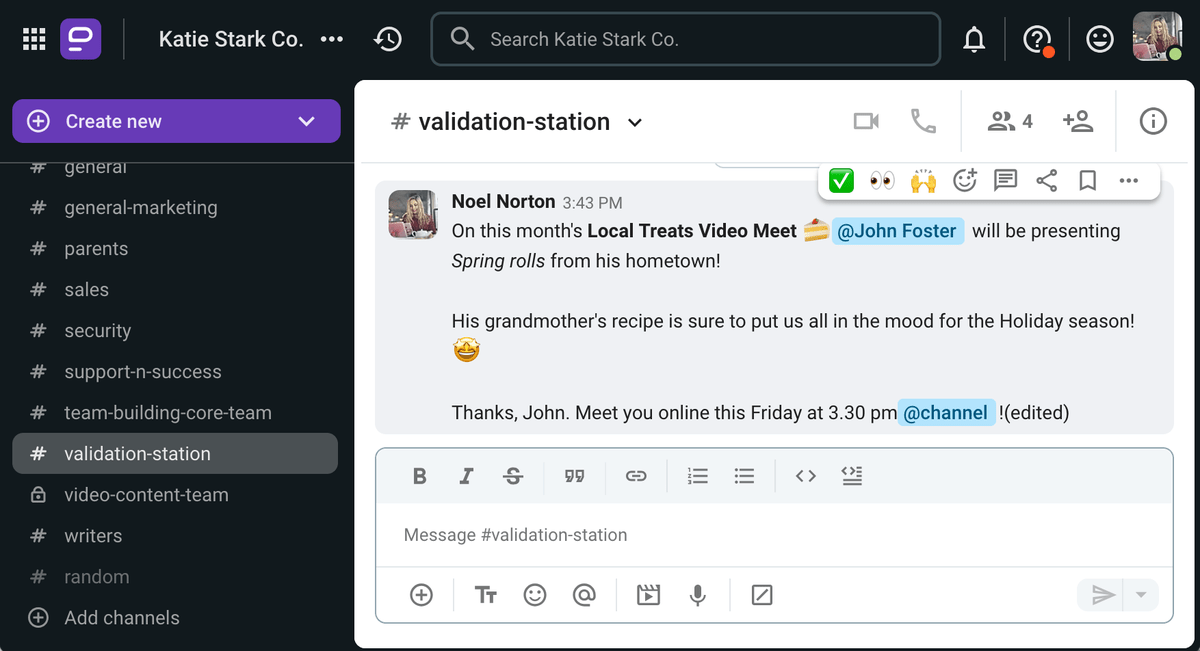
Hold team building sessions over Pumble
Example #10: Trust
Trust is the final result of all the previously mentioned elements. By this, we mean all possible kinds of trust:
- Trust in oneself,
- Interpersonal trust,
- Trust in the company, and
- Trust in the team’s and organization’s positive future.
Trust is a driver of employee engagement, which is why fostering it is vital.
Since trust is only achieved after all other team dynamics have been firmly established in your company, it is one of the most difficult things to accomplish. To evaluate overall trust in the company, you need to be aware of your employee satisfaction.
One of the ways to analyze employee satisfaction is to try to map out their needs and assess whether they’re being satisfied.
American psychologist Abraham Maslow arranged human needs in a hierarchy, with physiological (or “survival”) needs at the bottom, and creative and intellectually oriented (“self-actualization”) needs at the top.
He argued that survival needs must first be satisfied before a person can fulfill their higher needs.
This approach can also be applied to the workplace — the perfect one being the place where most employees reach the “self-actualization” stage.
Applying Maslow’s hierarchy of needs to the workplace
Employees who trust their company are loyal and, therefore, the ones who are the least likely to consider leaving. These team members are often called motivators. They are proud of their achievements and find different ways to help others, they actively better an organization, and overcome challenges.
The motivators are both emotionally and intellectually invested in their work and are eager to improve themselves and others, thus improving the company.
The number (or percentage) of these individuals in your organization will vary depending on factors such as the size of your business, the structure of your organization, and individual satisfaction and commitment.
The graph below shows the types of employees based on Abraham Maslow’s hierarchy of needs, applied to the workplace.
Ideally, you should be striving to have as many motivators and as few demotivators as possible.
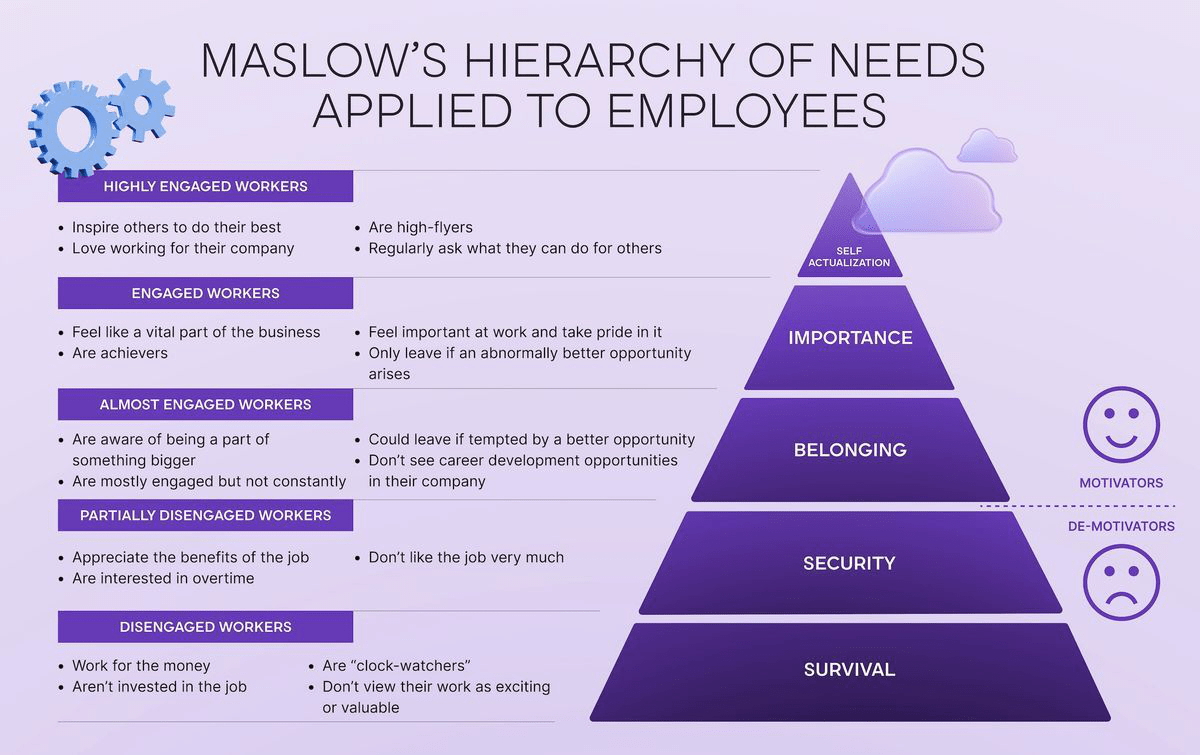
What are the benefits of effective team dynamics?
As you can see, the effects of improved team dynamics reach the very core of any organization.
Now that we’re familiar with the examples, let’s look at some of the most notable benefits of improved team dynamics.
Benefit #1: Increased productivity
If you’re aiming to ensure seamless collaboration and create a productive team, improving team dynamics is one of the best ways to do it naturally.
Imagine having an employee who’s inspired to communicate transparently, knows exactly what they should be doing, and influences others to do the same. Sounds ideal, right?
Obviously, having all of your team members simultaneously overflowing with enthusiasm each day is a highly improbable scenario. However, if team dynamics are established correctly, people will drive each other towards the common goal much more frequently, motivate each other through difficult days, and strive for optimal results.
Even though individual differences can be a hindrance, the differences in productivity between teams with and without effective team dynamics will always be apparent.
🎓 Pumble Pro Tip
If you’re looking for a way to improve your team’s performance, check out:
Benefit #2: Increased job satisfaction
Increased job satisfaction is in direct correlation with improved team dynamics.
Depending on how “difficult” your team is and their openness and satisfaction, the way you strategize team dynamics improvements might require more or less planning.
In any case, if this change is gradual, thought out, and slowly makes a significant impact by targeting primary problems first — job satisfaction will follow.
Working on significantly improving the team dynamics will lessen negativity and slowly snowball into a positive change. In turn, your employees will be more satisfied with their work environment and less likely to leave the company or obstruct its success.
Benefit #3: Better employee retention
Satisfied employees with a sense of purpose, a feeling of safety, and a constant motivation to improve are far less likely to consider leaving their jobs.
Although many factors play a role in a person’s choice to stick to a company, a fair percentage of employee retention is in the hands of a good manager. According to a Gallup survey, 42% of people who have voluntarily left their jobs, acknowledge that their manager could have done something to prevent it.
Of course, it takes a lot of effort and dedication to build a positive environment in the first place. But when done from the ground up, all it takes is subtle adjustments for a team of any size to function well.
🎓 Pumble Pro Tip
To learn more about reducing turnover rates and increasing your employee retention, read up on our blog:
How can you improve team dynamics?
Depending on the current state of your team or organization, to improve your team dynamics, you might have to take a unique approach.
However, the following directions are almost universal:
- Nurture direct and open communication,
- Get to know your team on a personal level, and
- Establish trust.
You can nurture open communication in a few different ways. You need to be ready to analyze your entire organization to learn how people interact and what potential communication challenges they might be facing.
Regardless of the current state of communication in your workplace, communication is one thing that can always be further improved.
To achieve this, you need to get to know your team on a personal level. This is best done through one-on-one meetings, which should be designed to make the employee feel as relaxed as possible. By engaging in small-talk, you can find out a lot about your employees, their pet peeves, soft spots, and similar.
Hold your one-on-one meetings over Pumble
Then, you can use that knowledge to your advantage.
For example, imagine an introverted coworker who is having trouble fitting in, although they would like to. Now let’s say that, during your meeting with them, you find out they have a dog. Then, to encourage them to participate in casual communication with others, you decide to post a funny picture of a dog on #random channel on Pumble.
This small act can inspire others to inquire about the picture and you get a small talk going, subtly nudging your coworker in the desired direction.
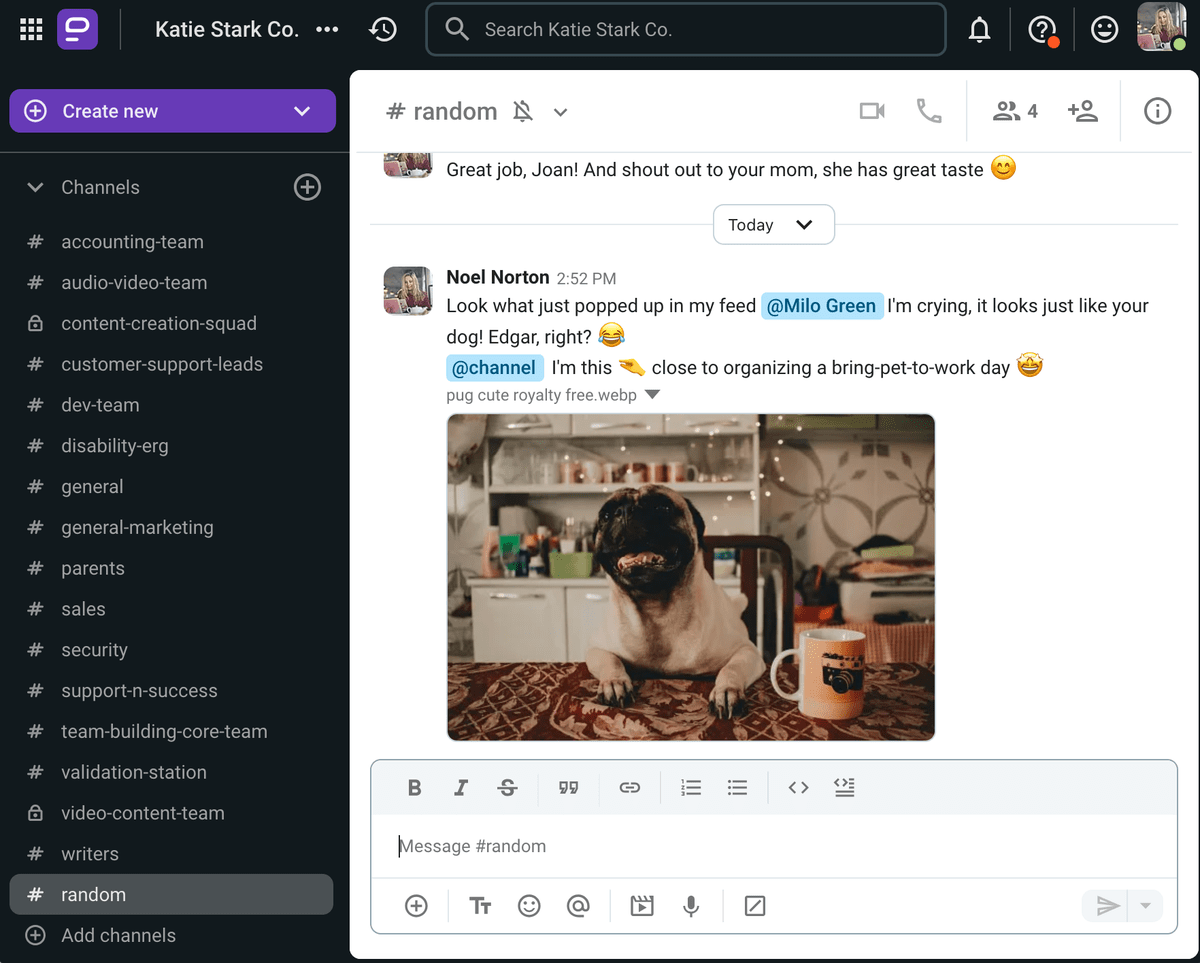
Doing this with all of your team members, and being careful to structure your “encouragements” so as not to trigger any pet peeves or fundamental disagreements is something that will lead to establishing trust.
With all individual colleagues as well as sub teams and teams trusting you, you will slowly develop a dedicated team, where everyone feels heard and appreciated.
The biggest challenges in achieving great team dynamics
Let’s take a look at the biggest challenges that you need to overcome or eliminate before implementing new team dynamics.
Challenge #1: Lack of structure in an organization
This is one of the primary challenges in an organization. When duties clash and initiatives are confronted, things tend to get messy quickly — and these are only the most obvious ways to recognize this problem.
A lack of structure in an organization can be identified in numerous ways. Too many things done by the CEO, without any time for strategic thinking? Bad team structure. Experiencing poor team performance? Inadequate team structure could be the culprit.
To identify whether your organizational structure could use improvement, try to ask yourself:
- Is there a clear hierarchy in the workplace?
- Is there any management overlap?
- Are there any occasional or regular conflicts and why do they happen?
- Are there any processes and procedures that seem overly complicated? Could they be simplified?
Getting a straightforward answer to these questions will help you identify the exact areas where your organization needs improvement.
Challenge #2: Unhealthy competition
Another detrimental thing to watch out for is unhealthy competition in your team.
The definition of unhealthy competition is when your employees focus on outshining their colleagues rather than contributing to common goals.
Of course, this can either be prevented by a good manager or further inspired by a bad one.
Make sure to motivate your employees to work together and help each other solve problems instead of competing with one another.
To avoid this, you might even be required to change the way you do your business. Even though you may be reluctant to do so, you should put a stop to unhealthy competition as soon as possible, as it will most likely solve many of your problems (and even some you may not be aware of).
Challenge #3: Poor communication
Before reaching openness in communication, you should first optimize it to be straightforward and effective.
If you’re noticing poor dynamics in your workplace, the first thing you should start improving is the way people share information.
Some of the ways to improve communication include:
- Simplifying your communication process,
- Fostering transparent communication, and
- Slowly building interpersonal trust by increasing the number of short meetings and promoting simple team activities.
Focus on creating small team victories each day.
This way, team members can get used to each other more easily. Frequent team syncs and weekly, monthly, and other types of meetings can also help.
After getting to your desired level of effectiveness, the next step is to encourage openness and a constructive approach to communication. That’s when the true team dynamics transformation can begin.
Transform your team’s dynamics with Pumble
One of the most effective solutions to organize communication efforts in a team is a dedicated team communication platform like Pumble.
Pumble is a team communication app designed to act as your digital HQ where members can be added to channels and groups as needed. This all-in-one communication tool allows you to improve the transparency of your team communication and develop communication processes for a team of any size.
Pumble’s features apply to remote, on-site, and hybrid work environments. Some of the most notable ones include:
- Direct messages — for 1 on 1 bonding between employees,
- Channels — for building strong teams through group conversations,
- Threads — for clear and effective communication during topic-oriented discussions,
- Video conferencing — for important real-time engagement and building trust,
- Video meet recording — to revisit the most important parts of video meets, and
- File sharing — for improved transparency and simplicity of team collaboration.
These, among many other Pumble’s features, will ensure seamless communication in your team and significantly simplify your collaboration.
Reduce points of conflict, create informal channels for a more casual team bonding experience, and focus all your communication efforts on a single platform.
Ensure great team communication and improve your team’s dynamics — try Pumble by CAKE.com for free today!
How we reviewed this post: Our writers & editors monitor the posts and update them when new information becomes available, to keep them fresh and relevant.


